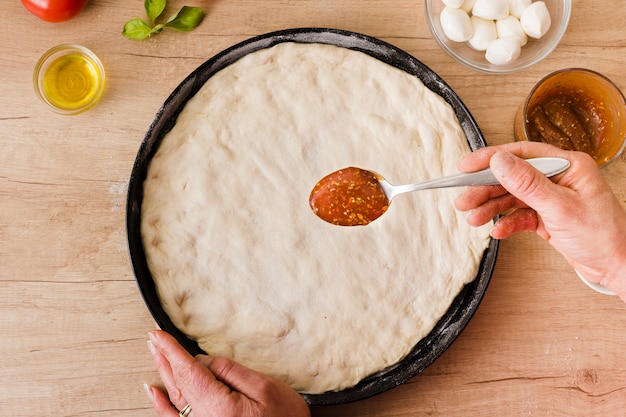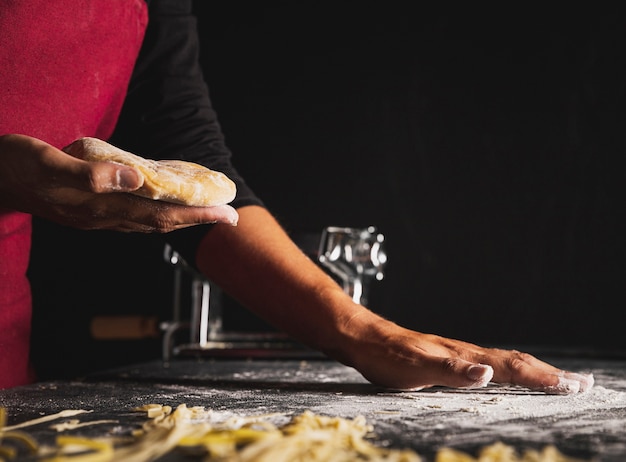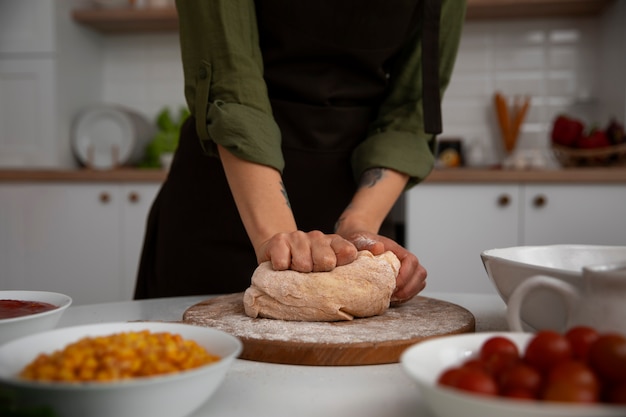I've always been a bit of a pizza purist. Give me a classic margherita, a generous helping of pepperoni, or a good old-fashioned meat feast, and I'm happy as Larry. But lately, I've been venturing into the world of calzones, and let me tell you, it's been a revelation. There's something so satisfying about biting into a crispy, golden-brown pocket filled with cheesy, delicious goodness. It's like a pizza party in your mouth, but in a much more manageable, portable format.
But when it comes to making the perfect calzone, the question of cooking time always seems to be a bit of a mystery. You've got your dough, your filling, your cheese, and your oven, but how long do you actually need to bake the thing to achieve that glorious, golden-brown perfection? Well, let's delve into the art of calzone baking and unravel the secrets to achieving that perfect bite.
Part 1: The Importance of Baking Time

You wouldn't want to underbake a calzone, would you? I mean, imagine biting into a soggy, doughy mess that hasn't quite reached its full potential. That's a culinary crime, my friends. But equally, you don't want to overbake it either. Nobody likes a burnt, crispy, rock-hard calzone. Finding that sweet spot in baking time is essential for achieving ultimate calzone nirvana.
The Science Behind Baking Time
Let's get a bit technical for a moment. The baking time for a calzone depends on a few key factors:
- The size of your calzone: A larger calzone will naturally take longer to cook through than a smaller one. Think about it – a larger calzone has more filling and a greater volume of dough to cook through. A smaller calzone, on the other hand, has less to bake, so it cooks faster.
- The thickness of your dough: A thicker dough will require more time to bake. Think of a thick, fluffy calzone as a cozy blanket for your filling. That cozy blanket needs a bit more time in the oven to ensure it's cooked through. A thinner calzone, with a less substantial dough, cooks more quickly.
- The type of filling: A filling with lots of moisture, like ricotta cheese or spinach, will take longer to cook than a drier filling like pepperoni or sausage. Moisture takes longer to cook through, so it's essential to consider the water content of your filling when determining baking time. A drier filling, like pepperoni or sausage, will cook more quickly.
- The temperature of your oven: A hotter oven will cook your calzone faster than a cooler one. A hot oven provides intense heat, accelerating the cooking process. A cooler oven, on the other hand, will take more time to cook your calzone evenly. Always preheat your oven to the recommended temperature for the best results.
Understanding these factors is key to determining the optimal baking time for your masterpiece. Don't worry, I'll give you a clear roadmap later on, so you won't be left guessing.
Part 2: Preparing Your Calzone

Before we get into the nitty-gritty of baking time, let's talk about preparing your calzone. The perfect calzone starts with a good foundation.
The Dough: Your Calzone's Backbone
You can buy pre-made pizza dough, but honestly, making your own is a real treat. There's something satisfying about kneading the dough, watching it rise, and knowing you're starting from scratch. The process of creating your own dough allows you to control the texture and flavour, resulting in a more personalized calzone experience. But if you're short on time, a store-bought dough will work just fine. Just make sure it's a good quality dough, and don't be afraid to experiment with different types, like whole wheat or gluten-free options.
The Filling: The Heart of the Matter
Here's where the fun really begins. The filling is where you can unleash your creativity and experiment with different flavours and textures. My personal favourite calzone filling is a classic blend of ricotta cheese, mozzarella, and pepperoni, but you can add anything your heart desires. Mushrooms, spinach, onions, bell peppers – the possibilities are endless.
Just remember, if you're using a lot of moisture-rich ingredients, it's a good idea to pre-cook them before adding them to your calzone. This will help prevent a soggy mess. For example, if you're using spinach, it's best to sauté it until it's wilted and any excess moisture is released. This way, your calzone will have a nice balance of textures and won't be too wet. The same goes for other moisture-rich ingredients, like mushrooms or ricotta cheese.
Assembling Your Calzone
Once your dough is ready and your filling is prepped, it's time to assemble your masterpiece. Roll out your dough into a circle or rectangle, depending on your preference. A circle shape is classic and allows for a symmetrical calzone, while a rectangular shape offers more flexibility for larger fillings. Spread your filling evenly over half of the dough, leaving a border around the edges. This border will act as a seal, preventing the filling from spilling out during baking. Fold the dough over the filling, sealing the edges tightly to prevent any leaks. You can use your fingers, a fork, or even a rolling pin to create a tight seal.
Now, here's a tip I learned the hard way: Brush the top of your calzone with a beaten egg or milk before baking. This will give it a lovely golden-brown crust. The egg or milk creates a glossy surface, which helps the calzone achieve a beautiful golden-brown color in the oven. It also adds a touch of richness to the crust.
Part 3: Calzone Baking Time: A Guide

Okay, let's get down to brass tacks and talk about baking time. The following is a general guideline for baking calzones, but it's always a good idea to check the internal temperature to ensure it's cooked through. This is especially important if you're using a lot of moisture-rich fillings.
Calzone Baking Times (Preheated Oven at 400°F/200°C)
| Calzone Size | Baking Time |
|---|---|
| Small (6-8 inches) | 15-20 minutes |
| Medium (10-12 inches) | 20-25 minutes |
| Large (14-16 inches) | 25-30 minutes |
Remember, these are just estimates. The actual baking time may vary depending on the thickness of your dough, the amount of filling, and the type of oven you're using. If you have a convection oven, you may need to reduce the baking time by a few minutes. Always keep a close eye on your calzone as it bakes, and check it for doneness before the estimated time is up.
Part 4: Calzone Baking Techniques: Tips and Tricks
Here are some tips and tricks to help you bake the perfect calzone:
- Use a baking sheet: Baking your calzone on a baking sheet will help ensure even cooking and prevent it from sticking to the bottom of the oven. A baking sheet provides a stable surface for the calzone to bake evenly, and it also helps to catch any drips or spills from the filling.
- Flip it over halfway through baking: Flipping your calzone over halfway through baking will help ensure that both sides are cooked evenly. This is especially important if you're using a thicker dough or a lot of filling. Flipping the calzone allows both sides to receive direct heat from the oven, resulting in a more evenly cooked calzone.
- Use a pizza stone: If you have one, a pizza stone can help create a crispy crust. A pizza stone absorbs heat and distributes it evenly, creating a crispy crust that's both flavorful and satisfying.
- Check the internal temperature: Use a meat thermometer to check the internal temperature of your calzone. It should reach 165°F/74°C. Checking the internal temperature ensures that the dough is cooked through and any moisture-rich fillings have reached a safe temperature. This is particularly important for fillings that contain meat or eggs.
- Use parchment paper: Lining your baking sheet with parchment paper can make cleanup a breeze. It also prevents the calzone from sticking to the baking sheet, making it easier to transfer to a serving plate.
Don't be afraid to experiment with different baking techniques and find what works best for you. There's no one-size-fits-all approach to calzone baking. The best way to find your ideal method is through trial and error.
Part 5: The Art of Calzone Baking: Knowing When It's Done
While the guidelines are helpful, there's a certain "feel" you develop when it comes to calzones. It's a bit of a culinary intuition, and it comes with practice. It's like knowing when a cake is done – you can usually tell by the smell, the texture, and the appearance. Here are some signs that your calzone is ready to come out of the oven:
- Golden-brown crust: The calzone should have a lovely golden-brown crust, indicating that it's cooked through. A golden-brown crust is a sign that the dough has achieved a nice balance of crispiness and tenderness. It also indicates that the filling is cooked through and ready to enjoy.
- Firm to the touch: The calzone should feel firm to the touch, not soft or doughy. If the calzone is still soft or doughy, it needs more time in the oven. A firm calzone is a sign that the dough has cooked through and is ready to be enjoyed.
- No jiggling: When you gently shake the baking sheet, the calzone should not jiggle or move around. This means the dough is set. If the calzone is still jiggly, it needs more time in the oven to set properly.
- Internal temperature: As mentioned before, the internal temperature of the calzone should reach 165°F/74°C. This ensures that any moisture-rich fillings have been cooked through and are safe to eat.
If you're unsure, it's always better to err on the side of caution and bake it for a few more minutes. A slightly overbaked calzone is better than an underbaked one. An overbaked calzone may have a slightly harder crust, but it will still be delicious. An underbaked calzone, on the other hand, can be doughy and unsafe to eat.
Part 6: Calzone Perfection: Cooling and Serving
Once your calzone is baked to perfection, let it cool slightly before cutting into it. This will help prevent the filling from spilling out everywhere. A hot calzone can be difficult to handle, and the filling may be too hot to eat right away. A few minutes of cooling time will allow the calzone to firm up and prevent any messy accidents.
When serving your calzone, you can keep it simple with a side of marinara sauce, or get creative with your toppings. A sprinkle of parmesan cheese, some fresh basil, or a drizzle of olive oil can elevate your calzone to new heights. You can even serve your calzone with a side salad or some roasted vegetables for a complete meal.
Part 7: Calzone Variations: Expanding Your Horizons
You don't have to stick to traditional calzone fillings. The beauty of calzones is their versatility. Here are a few ideas to get your creative juices flowing:
- Breakfast Calzones: Start your day with a delicious calzone filled with scrambled eggs, bacon, sausage, and cheese. Breakfast calzones are a great way to enjoy your favorite breakfast foods in a convenient, handheld format. You can even add some breakfast potatoes, peppers, or onions for extra flavor and texture.
- Sweet Calzones: For a sweet treat, try filling your calzone with Nutella, fresh fruit, and a sprinkle of powdered sugar. Sweet calzones are a decadent dessert option that's perfect for satisfying your sweet tooth. You can even add a dollop of whipped cream or some ice cream for extra indulgence.
- Vegetarian Calzones: Load up your calzone with vegetables like mushrooms, onions, bell peppers, and spinach, along with a generous amount of cheese. Vegetarian calzones are a delicious and nutritious option for those who avoid meat. You can experiment with different cheese combinations, like feta, mozzarella, or provolone, to create your perfect vegetarian calzone.
- Global Flavours: Experiment with international flavours, such as a Thai-inspired calzone with peanut sauce, chicken, and vegetables. Global-inspired calzones allow you to explore different cuisines and create unique flavor combinations. You can also try Indian-inspired calzones with tandoori chicken, curry sauce, and vegetables, or Mexican-inspired calzones with chorizo, salsa, and cheese.
The possibilities are endless. So get creative and have fun with it! The beauty of cooking is that it's an opportunity to express yourself through flavor and creativity. Don't be afraid to experiment and try new things – you might just discover your next favorite calzone combination!
Part 8: FAQs: Calzone Conundrums Answered
Here are some frequently asked questions about calzone baking:
Q1: Can I freeze calzones?
Absolutely! You can freeze unbaked calzones for up to 3 months. Simply place them in a freezer-safe bag and bake them directly from frozen, adding a few extra minutes to the baking time. Freezing unbaked calzones is a great way to save time and have a delicious meal ready on demand. Just make sure to thaw the calzone in the refrigerator overnight before baking.
Q2: Can I reheat calzones?
Yes, you can reheat calzones. The best way to do this is to bake them at 350°F/175°C for about 10-15 minutes, or until they're heated through. You can also reheat them in a microwave, but they won't be as crispy. If you want to enjoy the crispy texture of a freshly baked calzone, baking is the best method. Microwaving can make the calzone soggy, so it's best to avoid this method unless you're in a hurry.
Q3: What if my calzone is too thin?
If your calzone is too thin, it's more likely to break during baking. You can try to patch it up with a bit of extra dough or a few toothpicks. If the dough is very thin, it's best to bake it in a smaller oven to prevent it from burning. A thin calzone can easily tear or break, making it difficult to handle and cook properly. Adding a little extra dough to reinforce the seams can help prevent breakage. If you're using a thin dough, it's best to bake it at a lower temperature to prevent it from burning.
Q4: What if my calzone is too thick?
A thicker calzone will take longer to bake. You'll need to adjust the baking time accordingly. Make sure to check the internal temperature to ensure it's cooked through. A thick calzone may require a longer baking time to ensure that the dough and filling are cooked through. It's also important to check the internal temperature of the filling with a meat thermometer to ensure that it has reached a safe temperature.
Q5: What if my calzone is not golden brown?
If your calzone is not golden brown, it may be because it's not cooked through. You can bake it for a few more minutes, or until the crust is golden brown. If you've already baked it for a long time and it's still not golden brown, try broiling it for a few minutes to brown the top. A golden-brown crust is a sign that the calzone has been baked properly and has achieved a nice balance of crispiness and tenderness. If your calzone is not golden brown, it may need a little more time in the oven or a quick broil to achieve that desired color.
Part 9: The Final Bite: Embracing the Calzone Journey
So there you have it, a comprehensive guide to baking the perfect calzone. Remember, the key to a good calzone is a little bit of practice, a lot of creativity, and a whole lot of love. Don't be afraid to experiment, try new fillings, and find what works best for you.
After all, baking a calzone isn't just about the perfect bite, it's about the journey. It's about the fun of creating something delicious with your own two hands. It's about sharing that deliciousness with loved ones and creating memories around the table. So, go forth and conquer the world of calzones!
Everyone is watching

Prime Rib Roast Cooking Time Chart: Per Pound Guide
Cooking TipsPrime rib roast. Just the name conjures images of lavish dinners, crackling fires, and hearty laughter. It’s ...

How Long to Bake Potatoes in the Oven (Perfect Every Time)
Cooking TipsBaked potatoes are a staple in my kitchen. They're incredibly versatile, delicious, and surprisingly easy to m...

Perfect Rice Every Time: The Ultimate Guide to Cooking Rice
Cooking TipsAs a self-proclaimed foodie, I've always been a bit obsessed with rice. It's the foundation of countless cuisi...

The Ultimate Guide to Cooking Asparagus: Tips, Techniques, and Recipes
Cooking TipsAsparagus. The mere mention of this spring delicacy conjures up images of vibrant green spears, crisp and burs...

Ultimate Guide to Cooking the Perfect Thanksgiving Turkey
Cooking TipsThanksgiving. Just the word conjures up images of overflowing tables laden with delicious food, the scent of r...
